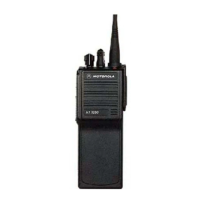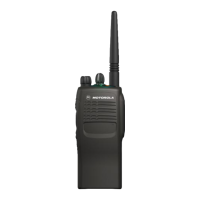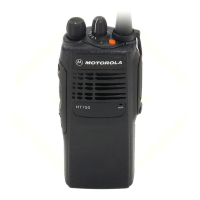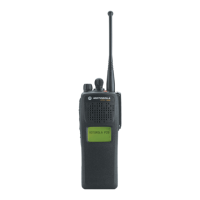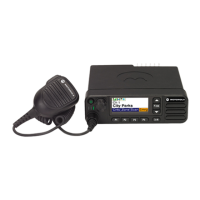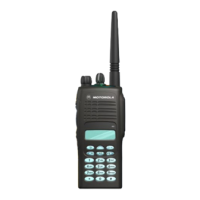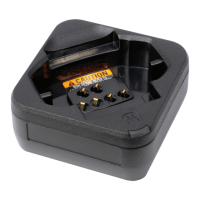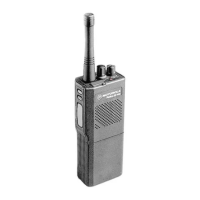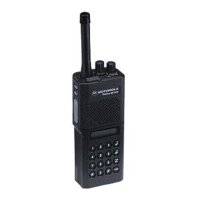6. Press F10, F2, then F10 again to return to the ser-
vice menu.
F. Transmitter Power
VHF and UHF radios require two power-level
adjustments, a high-power or rated-power adjustment,
and a low-power adjustment. The low power adjust-
ment is required since the radio may be used in a
reduced power mode, or with a vehicular adapter.
NOTE
All power measurements are to be made at the
antenna port.
1. From the SERVICE menu, press F2 to select
TRANSMITTER alignment.
2. Press F3 to select the TRANSMIT POWER softpot.
The screen will indicate the transmit test frequen-
cies to be used.
3. Begin with the highest test frequency shown.
4. Press F6 to key the radio, and use the UP/DOWN
arrow keys to adjust the transmit power per the
value shown in Table 40-15.
5. Press F6 to dekey the radio, and then press F8 to
program the value.
6. Repeat steps 4-5 for the remaining test frequencies.
7. Press F10, then F2 to return to the TRANSMIT
menu.
G. Transmit Deviation Balance (Compensation)
Compensation alignment balances the modulation
sensitivity of the VCO and reference modulation (syn-
thesizer low frequency port) lines. The compensation
algorithm is critical to the operation of signalling
schemes that have very low frequency components
(e.g. DPL) and could result in distorted waveforms if
improperly adjusted.
NOTE (Secure-Equipped Only)
If a secure module is currently installed in the radio
being aligned, refer to the appendix at the rear of this
manual. Read section III, “Secure Alignment Proce-
dure”, before performing the transmit deviation
balance (compensation) procedure.
1. Press F4 to select the TRANSMIT DEVIATION
BALANCE softpot. The screen will indicate the
transmit test frequencies to be used.
2. Begin with the lowest test frequency shown on the
screen.
3. Set the Test Box (RTX4005B) meter selector switch
to the “MX DISC” position, and inject an
80 Hz tone at 100 mVrms into the AC/DC MTR port.
Keep the ac voltmeter in parallel to ensure the prop-
er input signal level.
4. Press F6 to key the radio, and measure deviation.
Record this measurement.
5. Change the input tone to 3 kHz, 100 mVrms and
use the UP/DOWN arrow keys to adjust the
deviation to within ±2% of the value recorded in
step 4.
6. Change the input tone back to 80Hz and measure
the deviation.
7. Repeat steps 5 and 6 until the 3 kHz tone deviation
is within ±2% of the 80Hz tone deviation.
8. Press F6 to dekey the radio, and press F8 to pro-
gram the softpot value. Press ENTER to move to
next softpot value.
9. Repeat steps 3-8 for the remaining test
frequencies.
10. Press F10 to return to the TRANSMIT menu.
NOTE
• The step size change for step 5 is approximately
2.5% per softpot value.
• This adjustment should only be made to
the 3kHz deviation. Do not adjust the 80Hz
deviation.
H. Transmit Deviation Limit
1. Press F5 to select the TRANSMIT DEVIATION
LIMIT softpot. The screen will indicate the transmit
test frequencies to be used.
2. Begin with the lowest test frequency shown on the
screen.
14
Table 40-15. Transmit Power Setting
VHF UHF
Power Test Frequencies Power Test Frequencies
Level 136-174MHz 177.975MHz Level 450-512MHz 512-520MHz
5 W 5.2 - 5.4 4.2 - 4.4 4 W 4.2 - 4.4 3.2 - 3.4
1 W 1.2 - 1.4 1.2 - 1.4 1 W 1.2 - 1.4 1.2 - 1.4
800 MHz 900 MHz
Power Power
Level All Test Frequencies Level All Test Frequencies
3 W 3.20-3.40 2.9 W 2.80 - 3.00
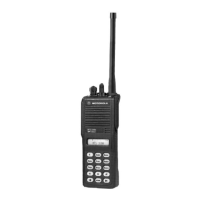
